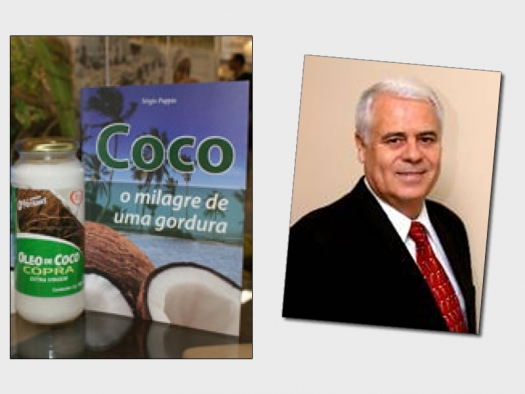Dr. Sérgio Puppin looks at the benefit of coconut oil compared to other fats and oils
Book review
CoconutTheMiracleofaFatSergioPuppin.jpg

Coconut, The Miracle Of A Fat by Dr. Sérgio Puppin
Dr. Sérgio Puppin is a cardiologist from Rio de Janeiro, Brazil. He is author of the book: Coconut, The Miracle Of A Fat. Due to requests from our patrons who do not read Portuguese, FAIM is giving an outline of the book.
In the brief introduction, the author highlights that coconut oil is composed of nearly 50% Lauric Acid (C12:0) that has important anti-viral and anti-bacterial properties. It also is composed of about 8% Caprylic Acid (C8:0) that has the power to eliminate fungus and intestinal parasites.
In the next two chapters, the author goes on to give a clear-cut warning on the dangers of modified fats such as margarine (that have gone through a sophisticated industrial process). They can harm the immune system, diminish fertility, damage DNA, increase certain types of cancer, promote cardiovascular disease and cerebral vascular accidents, increase the rate of osteoporosis, accelerate aging, compromise the electrical system of the heart (causing death), and worsen arthrosclerosis.
The author goes on to call these hydrogenated fats "silent killers" and gives a long, interesting and shocking list of explanations and anecdotes. For example, in the 1940s farmers realized that pigs fed with coconut oil lost weight. So they started giving the animals thyroid-suppressing drugs. But, in due time it was realized that these drugs caused cancer and had to be stopped. Finally, it was realized that by feeding the pigs soy and corn oil one could achieve the same effect as the thyroid suppressing drugs. Albeit, these same affects are produced in humans! Also, it was later discovered that unsaturated and polyunsaturated oils damage mitochondria. Plants produce these fats not so much as an energetic reserve for the germination of its seeds, but principally for their protection from predators. These oils inhibit enzymes used for the digestion of proteins; they damage the capacity for predators to absorb nutrients. These fats also promote inflammation, obesity, accelerated aging and interfere with the removal of blood clots. To protect oneself from the deleterious effects of these fats found in restaurant food, Dr. Puppin suggests a daily dose of vitamin E (100 IU) as well as vitamins A and C, zinc and selenium.
In the next chapter the author introduces canola oil (a genetic modification of colza oil) and the benefits people with Adrenoleukodystrophy can gain because of its high level of erucic acid (22:1 w-9 – as seen in the film Lorenzo's Oil). After that, the author gives us another long list of anecdotes and reasons one should not consume canola oil. For example, it produces serious organ degeneration (in rat experiments), is associated with fibrotic lesions in heart tissue, it causes rigidity in cellular membranes, causes vitamin E deficiency, etc.
In the fourth chapter, the author finally introduces saturated fats, which he calls a solution for all ills. For the past 50 years official medicine has told us to avoid fats and has demonized saturated fats. The relationship between cardiovascular disease and cholesterol is only a theory. Instead, the author says the culprits are high sugar consumption and diets rich in carbohydrates. Then he gives a list of benefits and reasons why one should consume saturated fats. For example, 50% of cellular membranes are made of saturated fats, they are essential for the incorporation of calcium into the bones, they protect the liver from damage caused by alcohol and other toxins, omega-3 fats are better absorbed in the presence of saturated fats, they improve the immune system, etc.
In the next chapter, in his style of a long list, the author goes into the scientific evidence that un-correlates saturated fats and cholesterol from cardiovascular disease.
Chapter 6 gives information on the benefits of coconut oil in the form of questions and answers. For example: how much coconut oil should we consume? The author recommends the same quantity of Medium Chain Triglycerides a baby can get from mother's milk. In adult equivalence, it is about 3.5 tablespoons a day.
Chapter 7 talks of the antimicrobial effects of coconut oil. In a study done at the San Lazaro Hospital in the University of the Philippines, Professor Contrato Dayrit used coconut oil to reduce the viral load of HIV+ patients. In the United States, Dr. Enig describes a HIV+ baby that tuned negative after high doses of coconut oil were introduced in its formula milk. Many readers might object that such an experience is completely circumstantial. An Indian journal published the following powerful statement by Dr. Enig: monolaurin, whose precursor is lauric acid, destroys the lipid membrane of viruses as well as inactivates bacteria, yeasts and funguses (Indian Coconut Journal).
Another anecdotal case is Chris Dafoe, an AIDS patient who had such a negative prognosis (CD4s=10 units/ml) that he decided to travel to Suriname to end his days. There, he started a diet rich in coconuts. Within a few of months he had regained his health and gained 30 pounds (www.coconutoil.com). Due to these and many more anecdotal cases, the Potato and Products Aid Alliance to Africa (PATA) has started to distribute coconut oil to HIV+ people.
The author continues the chapter with a case of Hepatitis C, which also was resolved by using coconut oil. Next come cases of Irritable Bowel Syndrome, Ulcerative Colitis and Crohn's Disease.
Chapter 8 is dedicated to effectively using coconut oil to lose weight. The following chapter explains that coconuts (the water, oil and meat) help to eliminate parasites.
Chapter 10 is dedicated to Diabetes and the usefulness of eliminating polyunsaturated oils. Coconut oil increases cellular sensitivity to insulin (so less is needed).
Chapter 11 is devoted to Syndrome X (Insulin resistance + high blood pressure + high triglycerides + high cholesterol + high uric acid + obesity) provoked by modern lifestyle and wrong diet for which coconut oil is a solution.
Chapter 12 talks about using coconut oil to treat Chronic Fatigue Syndrome and Fibromyalgia.
Chapter 13 is dedicated to the thyroid. Its malfunction can cause more that 90 different clinical symptoms. The author claims that 20% of women over the age of 55 suffer from hypothyroidism. Adding to the above-mentioned issue of the suppressing effect of polyunsaturated fats, many industrialized foods, refined sugar, food preservatives, fertilizers, pesticides and fluoridated water are also toxic for the thyroid.
Chapter 14 gives advices for healthy skin and pretty hair: "say enough to chemical products."
Chapter 15 is entitled "a new and efficient weapon against cardiovascular disease." This chapter, pitifully short for being written by a cardiologist, gives a list a principle causes of cardiovascular disease (which are not cholesterol and saturated fats). They are genetics predispositions, toxic metals and free radicals, bacteria, fungus and viruses, tooth infections, hypertension, hypothyroidism, refined foods, esterified fats, vegetable oils and margarines, stress, diabetes and dyslipidemia. He says that the arteriosclerotic process is a complicated inflammatory process and that a diet with a healthy equilibrium of minerals, vitamins and antioxidants can help limit the degenerative effects. The author says that populations that use high quantities of coconuts (i.e. Sri Lanka) do not suffer from cardiovascular disease.
Chapter 16, the author warns on the dangers of esterified fats.
Chapter 17 gives a summary of his book and recommends the publications by Bruce Fife and Mary Enig.
Chapter 18 gives the latest news on the benefits of coconut oil. The first section describes its usefulness to fight pneumonia in babies and children. The second part is on the use of coconut oil as a source for energy for athletic performance (to be taken in the days before the competition). The third part has an interesting report on the use of coconut oil to treat Alzheimer's disease (AD). The author proposes that AD is type 3 Diabetes where there is an insulin resistance of the nervous cells. Coconut oil can help solve this problem by offering a different metabolic pathway for supplying energy to the cells.
The second part of the book is a series of coconut recipes by Ana Ribeiro, a renowned chef of traditional Brazilian cuisine. The book ends with a very thorough bibliography.
Title of book: Coco, o milagre de una gordura
Author: Sérgio Puppin, MD
ISBN: 978-85-909562-0-4
Published in 2009, in Portuguese language, 223 pages
No publisher mentioned. Self-published in Brazil by Artim Graphic Design Studio (email: artimcontacto@ig.com.br).


